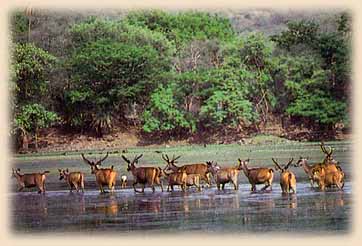
Welcome |
|
|
|
|
|
|
|
|
|
|
|
|
|
|
|
|
|
|
|
|
|
|
|
|
|
|
|
|
|
|
|
|
|
|
|
|
|
|
|
|
|
|
|
|
|
|
|
|
|
|
|
|
|
|
|
|
|
|
|
|
Sariska National Park |
|
Sariska National park is one of the India’s most exciting wildlife
reserves. Sariska National Park lies in the Aravalli hills and spread over
a core area of 498 square km. This park can be easily reached from Alwar,
Delhi and Jaipur and about 40 km from Alwar and 107 km from Jaipur. Once,
Sariska was the hunting ground of the Maharajas of Alwar, but later became
a wildlife sanctuary in 1958 by the government of India. In 1979, it was
brought under the Project Tiger and was given a status of national park in
1982.
|
 |
|
The landscape in Sariska comprises of low hills, wide valleys, steep
escarpment, hill plateaus and narrow valleys of the Aravali hill range. The topography supports scrub-thorn arid forests, dry deciduous forests, rocks and grasses. The major plants that one can find here are
dhok, khair, tendu and ber.
The plants remain lush and green during the monsoon and summers. Today,
Sariska is a major milk producing region, and cattle have crowded the
forestlands and pastures around the park, so that the population of
wildlife has shrunk to the limits of the park alone. Human population and
the presence of religious spots around and inside the park have further
led to the deterioration of the environment.
|
|
|
|
| Major Attractions in the Sariska National Park |
|
The Sariska National Park is known for its tigers. According to the latest available data, there are about 35 tigers in the park here. Besides tiger, Sariska has a very good population of
Sambhar, Chital, Nilgai,
Leopard, Jackal, Hyena, Wild dog, Four-horned Antelope, Wild Boar, Common
Langur, Caracal, Jungle Cat, Porcupines and Crocodiles. Water holes have
also been created at various spots in the sanctuary. These water holes are now acting as the
nerve centers of the sanctuary and various animals can be easily seen here during summers.
Various tourists often gather at the hides located close to the waterholes
to view and photograph the animals. Besides animals various birds can also be seen in Sariska National Park
like Grey Partridges, White-breasted Kingfisher, Golden-backed woodpecker, Peacock, Red
Spurfowl,
Pigeons, Quails, Sand Grouses, Parakeets, Kites, Eagle. Owl and Vultures.
The Sariska National Park offers a wide range of activities such as a
jungle safari in and around the park in the mornings and evenings,
observing the wildlife at the waterholes, or photographing wildlife from
the many hideouts provided in the park.
|
|
|
| Best time to visit Sariska
National Park |
|
The sanctuary can be visited throughout the year except during July and August when animals move to higher ground. The best season to visit the park is from November to June. June is the best month for game viewing. The best way to visit the Sariska Wildlife Sanctuary is either by having a Jeep Safari
or Canter Safari.
Other Attractions in Sariska
National Park
There are also historical ruins and monuments within Sariska
which are the symbol of the rich past of Alwar. Various ancient temples
and forts are also situated within the premises of the park.
Kanakwari Fort:
Among the historic landmarks located within the Sariska national park, includes the Kanakwari
Fort. This is the fort where Emperor Aurangzeb once imprisoned his brother, Dara Shikoh. The Kanakwadi fort
also had links with Mughal history. Now overgrown with weeds and shrubs, it stands majestically on a hill overlooking the Kanakwadi
plateau.
Ancient Shiva Temple:
Within the area of the Sanctuary, Neelkanth temple, that
belongs from the 6th to 13th century AD, now in ruins, afford a wonderful sight to the visitors. This
ancient medieval temple is dedicated to the Lord Shiva.
Sariska Palace:
Sariska was known as the royal reserve of the rulers of Alwar. The Sariska Palace was built by the Maharajas of Alwar and this palace has now been converted into a
heritage hotel.
Siliserh Lake:
The Siliserh Lake is situated at the edge of the tiger reserve, just off the Alwar-Sariska
road. This lake has a palace overlooking the lake which has now been
converted into a tourist resort. Crocodiles are the major inhabitants of
this lake and observing them basking on the shores of the lake can be an
interesting experience.
|
|
|